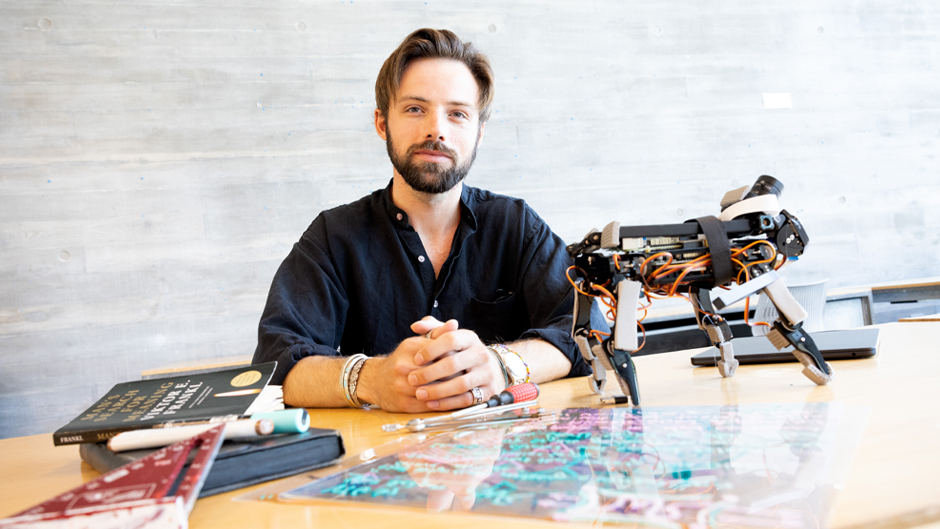University of Miami graduate Whitaker Redgate can’t be defined by one thing. He doesn’t consider himself an artist, or an architect, or even a computer programmer.
“As a kid, I always took things apart and wanted to build them. I always wanted to build crazy things like things that flew, or machines that could be remote controlled. I coded and painted things. My mom built a really cool world for me to do and explore all those things growing up,” said Redgate, a graduating senior studying management with an interdisciplinary focus on extended reality (XR) design at the Miami Herbert Business School. “But then, when you get to college, you feel like you have to pick just one thing.”
Instead of narrowing his studies, Redgate paved a wide path for himself at the University of Miami, taking as many opportunities as he could to merge these curiosities and skills to master emerging technologies through courses that allowed him to explore beyond the boundaries of traditional business studies.
By taking time to travel, including visits to 22 countries while completing his degree, and enrolling in various classes in the School of Communication, School of Architecture, College of Engineering, and the College of Arts and Sciences, Redgate dove into areas such as project management, XR/AI design, architecture, interactive media, and environmental studies to blaze a trail as an innovator.
“Working with multiple people that aren’t the same as you, that’s the real gift. Finding the people that don’t think like you, or don’t work like you—that’s where innovation comes from,” he said.
Through his professors, Redgate worked on several projects as part of the University’s XR Initiative as an XR software engineer and program manager. Among those projects was Mangrove City, a VR experience developed by a team of University faculty and staff members and students that offered a virtual glimpse of the crucial role mangroves play in protecting coastal communities and mitigating climate change. For the project, Redgate worked with Kim Grinfeder, chair of the Department of Interactive Media, and used aerial and terrestrial photogrammetry to make 3D models of the mangroves that are used in the virtual world.
Utilizing similar aerial and terrestrial photogrammetry work, he and his classmates also founded Precision Ecology, a remote sensing and data company that uses drone technology to create digital surface and terrain maps. The students’ project was selected and showcased as part of the University’s presence at the annual eMerge Americas tech conference in 2022.
Redgate said he relied heavily on the support of his professors from his various classes to pursue his creative ventures. Susana Alvarez, senior lecturer of entrepreneurship at the Miami Herbert Business School, highlighted how Redgate’s passion for emerging technologies and creativity sparked interesting dialogues during their Introduction to Entrepreneurship class.
“His questions were insightful, and his opinions were thought provoking. He even brought VR technology to class and let me experiment with it,” said Alvarez. “With his breadth of experience, his ability to go deep on the application of class concepts prompted spirited and relevant class discussions. Having Whit’s bright mind in class was a boon to us all.”
Outside of the classroom, Redgate pursued atypical internships and experiences to broaden his portfolio, too. In 2019, he spent eight months in London studying architecture at the University of the Arts London and working for Saw & Sew, a London-based sustainable luxury furniture company, as a design project manager building furniture.
Redgate also spent a summer in Tokyo with FORUM8 International as an augmented reality (AR) software engineer, where he researched and developed solutions for web-based XR features for the Japanese government, such as interface controlling using hand tracking. He turned down internship offers from Zoom and IBM to challenge himself by working in Japan for the summer. “It was really hard being in Japan. I was speaking three languages a day while coding things. It was cool to take the unconventional route of a summer internship,” he said.
While in Tokyo, Redgate received a call from a friend back home. III Points Music Festival in Miami had opened a design contest for artists from around the globe, and his friend encouraged him to submit a project. Pulling from his experience in computing, XR, and biomimicry—inspired by organic structures found in nature, like the mangroves he had previously mapped—Redgate got to work designing a 10x10 foot interactive art installation.
“I was like ‘Okay, a sculpture? That’s easy. Let’s build something immersive.’ I wanted to build an actual space that people could go in and interact with,” he said. “So, I got this idea that we would build a structure, filled with mirrors and lasers that we programmed to interact with the sound from the music festival.”
Much to Redgate’s surprise, his project was selected out of a pool of hundreds of artists. So, the creator tapped into his University network to bring the project to life together with Indrit Alushani, a research associate in the RAD lab at the School of Architecture and nine students. The team built Redgate’s “3022” sculpture and showcased it at the music festival in October.
“We’re trying to figure out how you take this concept and deploy it so it’s functional in the environment, especially in our changing world,” he said. Redgate envisions finding ways to replicate this installation and use it as a public art piece to teach communities about technology and the environment, while enhancing its functionality to provide more public green spaces, shade in neighborhoods with high heat indexes, or public access to power through solar powered outlets.
He is grateful for his time at the University, highlighting that the people, classes, and experience was crucial to his future.
“In my time at [the University], I’ve had the opportunity to do a lot. I really am going to miss it here because it’s a great environment,” Redgate said. “This whole concept that we’re building futurists and innovators here is really true.”

